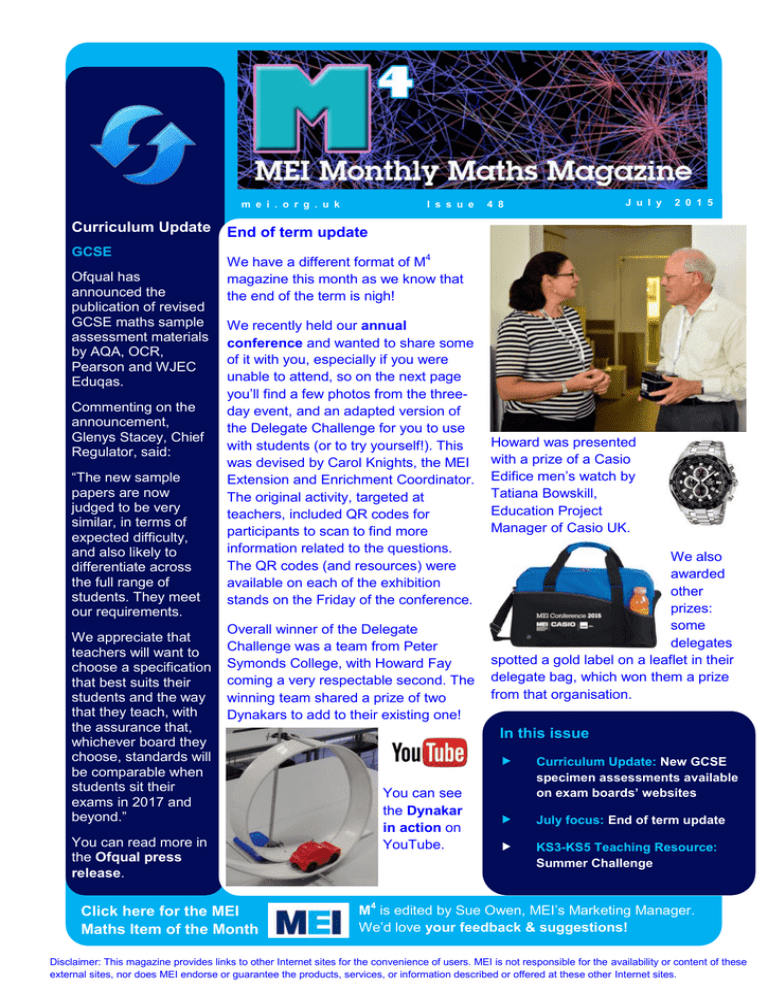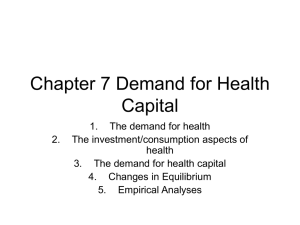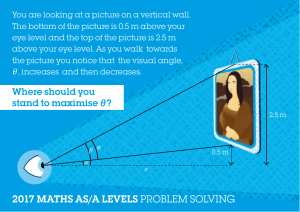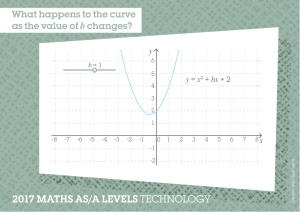Curriculum Update End of term update
advertisement

m e i . o r g . u k Curriculum Update GCSE Ofqual has announced the publication of revised GCSE maths sample assessment materials by AQA, OCR, Pearson and WJEC Eduqas. Commenting on the announcement, Glenys Stacey, Chief Regulator, said: “The new sample papers are now judged to be very similar, in terms of expected difficulty, and also likely to differentiate across the full range of students. They meet our requirements. We appreciate that teachers will want to choose a specification that best suits their students and the way that they teach, with the assurance that, whichever board they choose, standards will be comparable when students sit their exams in 2017 and beyond.” I s s u e J u l y 4 8 2 0 1 5 End of term update We have a different format of M4 magazine this month as we know that the end of the term is nigh! We recently held our annual conference and wanted to share some of it with you, especially if you were unable to attend, so on the next page you’ll find a few photos from the threeday event, and an adapted version of the Delegate Challenge for you to use with students (or to try yourself!). This was devised by Carol Knights, the MEI Extension and Enrichment Coordinator. The original activity, targeted at teachers, included QR codes for participants to scan to find more information related to the questions. The QR codes (and resources) were available on each of the exhibition stands on the Friday of the conference. Overall winner of the Delegate Challenge was a team from Peter Symonds College, with Howard Fay coming a very respectable second. The winning team shared a prize of two Dynakars to add to their existing one! You can read more in the Ofqual press release. Click here for the MEI Maths Item of the Month Howard was presented with a prize of a Casio Edifice men’s watch by Tatiana Bowskill, Education Project Manager of Casio UK. We also awarded other prizes: some delegates spotted a gold label on a leaflet in their delegate bag, which won them a prize from that organisation. In this issue You can see the Dynakar in action on YouTube. Curriculum Update: New GCSE specimen assessments available on exam boards’ websites July focus: End of term update KS3-KS5 Teaching Resource: Summer Challenge M4 is edited by Sue Owen, MEI’s Marketing Manager. We’d love your feedback & suggestions! Disclaimer: This magazine provides links to other Internet sites for the convenience of users. MEI is not responsible for the availability or content of these external sites, nor does MEI endorse or guarantee the products, services, or information described or offered at these other Internet sites. Delegate ideas Delegate Ideas We asked MEI Conference Delegates to share what ideas they would take away from the conference and share with their colleagues back at their school/college. The response to this was great: some delegates Tweeted their #MEIConf2015 #Ideas (follow the link to read these), while others wrote their ideas onto sheets and pinned them onto a noticeboard. We will put all of these ideas together onto a document and upload these to our MEI Conference 2015 archive, where in due course some of our session resources will also be uploaded. You can read more about the conference by searching for #MEIConf2015 on Twitter. MEI Conference 2015 New end of term resource The final teaching and learning resource of the academic year is a replica of the delegate challenge from MEI’s Annual Conference. There are 15 challenges, presented in approximate order of difficulty, for you and your students to enjoy. You should find some questions are suitable for KS3 students whilst others will challenge A level students. Some hints are provided after the relevant question and all answers are given in the teacher notes at the end of the resource. The PowerPoint version of the resource can be downloaded from the Monthly Maths web page - you can then remove the teacher notes and solutions before sharing it with your students! Have fun! M4 Magazine will return next term, when it will change to a half-termly issue. Challenge 1 Arrange all the digits 1 to 9, using them once each only, to form a fraction equivalent to 1/3 Challenge 1 Hint What could the 2 numbers end in? What could the first digit of the bottom number be? Challenge 2 A handywoman is going to fix numbers onto bedroom doors in a very large hotel. The numbers are supplied as individual digits. There are 1000 rooms, how many 7’s does she need? Challenge 3 Why is the number 8,549,176,320 special? Challenge 4 What are the smallest integer values of A, B and C such that the product of any two of the values added to the third gives a square number? Challenge 5 Find the three 4 digit numbers that equal the square of the sum of the two 2-digit numbers formed from the 1st and 2nd digits and 3rd and 4th digits. e.g. one that doesn’t work: 1546 ≠ (15+46)2 Challenge 5 Hint Can you use a spreadsheet to help you find them? Challenge 6 .-- .... .- - -.. --- -.-- --- ..--. . - .. ..-. -.-- --- ..-- ..- .-.. - .. .--. .-.. -.-... .. -..- -... -.-- -. .. -. . Help here Challenge 7 A set of 15 dominoes (all combinations of 1 to 5) is placed on a square grid as shown – except that the outlines haven’t 2 2 3 5 4 3 been given… What number is on the 2 1 3 2 5 4 other half of the domino 4 1 5 5 3 4 with the ‘1’ highlighted? 3 3 2 2 4 1 4 5 1 5 1 1 Challenge 7 Hints What are all the possible dominoes? Are there any dominoes that have to be in a certain place? 2 2 4 3 4 2 1 1 3 5 3 3 5 2 1 5 2 5 2 5 4 5 3 4 1 3 4 4 1 1 Challenge 8 Cherries are naturally 80% water. Dried cherries are made by leaving them in the sun until they have lost 75% of their water. What is the percentage water content of dried cherries? Challenge 9 Mia uses an escalator at a railway station. If she runs up 8 steps of the escalator, then it takes her 55 seconds to reach the top. If she runs up 15 steps of the escalator, it takes her 37.5 seconds to reach the top. How many seconds would it take Mia to reach the top if she did not run up any steps at all? Challenge 10 Each side of the triangle ABC is divided into 5 equal parts. What is the ratio of the area of the blue triangle to the area of ABC? B A C Challenge 10 Hints B C A A B C Challenge 11 A boat carries rocks on a small, still lake making the depth of water in the lake D. The rocks are released and sink to the bottom of the lake. Is the level of water in the lake now greater than, less than or the same as D? Challenge 11 Hint Think about a small marble made of gargantuan – a (fictitious) metal which is 1000 times as ‘heavy’ as lead. Challenge 12 A large number of sweets need to be eaten. Eating alone, it takes Hannah an hour to eat a jar of them, Mike 3 hours, Nat 5 hours and Oscar 7 hours. Eating together, how long, to the nearest minute, does it take them to eat their way through 3 jars of sweets? Challenge 12 Hints In 15 hours, Mike will have eaten 5 jars and Nat will have eaten 3 jars. Can you find a whole number of hours in which they will all have eaten full amounts of jars? Challenge 13 A symmetrical yellow crescent is formed from two circles as shown with O being the centre of the larger circle. AB = 5cm and CD = 9cm What are the diameters of the two circles? Challenge 14 The circumference of a circle is divided into n equal arcs and semi-circles constructed as shown. Can the blue shapes at the edge ever be equal in area to the orange petals? If so, what should n be? Challenge 14 Hint Try looking at just one blue shape and orange petal. Challenge 15 What is the internal side length of the smallest hollow cube which can wholly contain 4 identical spherical chocolates, each of diameter 10cm? Challenge 15 Hint Think about how the chocolates could be arranged. Some ping pong balls or tennis balls might be helpful. Teacher notes: Summer Challenge The final edition of the academic year is a replica of the delegate challenge from MEI’s Annual Conference. There are 15 challenges, presented in approximate order of difficulty, for you and your students to enjoy. You should find some questions are suitable for KS3 students whilst others will challenge A level students. Some hints are provided after the relevant question and all answers are given in the teacher notes below. Enjoy! Teacher notes: Summer Challenge Challenge 1 5832 17496 or 5823 17469 Challenge 2 300 Challenge 3 All the digits are in alphabetical order Challenge 4 1, 7 and 9 Teacher notes: Summer Challenge Challenge 5 2025 3025 9801 Sample spreadsheet columns below, searching for zero values in column G. For this solution it helps to work ‘backwards’ through the problem. Start with a number (A) and square it (B), split the square numbers into first pair and second pair (C leading to D&E), add them together (F), compare with original number (G). A B C D E F G 44 1936 19.36 19 36 55 11 45 2025 20.25 20 25 45 0 n n^2 B/100 int( C ) (C-D)*100 D+E F-A Teacher notes: Summer Challenge Challenge 6 What do you get if you multiply six by nine? 54 Challenge 7 4. Challenge 8 50% Challenge 9 75 seconds Challenge 10 8:25 look for triangles of equal base and height. Challenge 11 Less than D. When the rocks are in the boat, the mass of water displaced is equal to the mass of the rocks, when in the water, the volume of water displaced is equal to the volume of the rocks. Since the rocks sink, their density is greater than 1, hence more water is displaced when the rocks are in the boat than when they are in the water. Teacher notes: Summer Challenge Challenge 12 1 hour and 47 minutes Find the lowest common multiple of the number of hours for each person to eat a jar. In 105 hours, Hannah eats 105 jars, Mike 35, Nat 21 and Oscar 15. That’s 176 jars between them. 176 jars in 105 hours (6300 minutes), so use proportional reasoning to find how long it takes to eat 3 jars. Challenge 13 50cm and 41 cm Teacher notes: Summer Challenge Challenge 14 8 Consider the circle to have a radius of 2r, then the area of the circle is 4πr2 Looking at a single sector and ‘petal’, blue area=orange area only if area of sector = area of semicircle Area of semicircle is 0.5πr2 Area of sector = 0.5πr2 when there are 8 sectors Teacher notes: Summer Challenge Challenge 15 10+5√2 or an equivalent expression The chocolates should be arranged as a tetrahedron with each chocolate nestling in a vertex. This means that 2 chocolates will sit diagonally at the bottom of the box and 2 at the top. Use this 2d diagram to calculate the size of the square.



